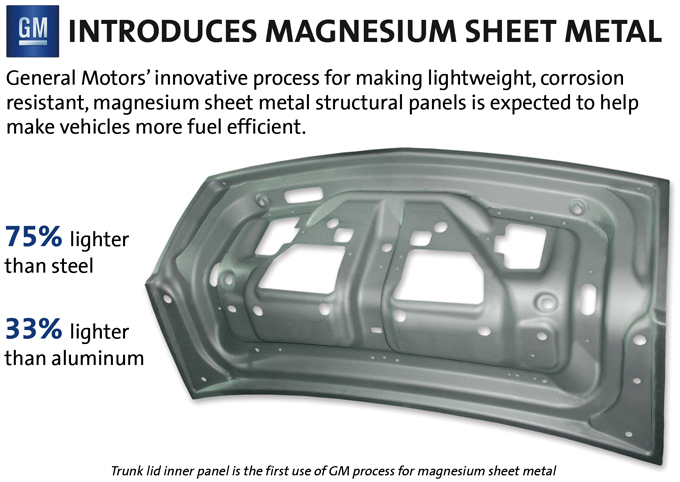Magnesium Shows High Potential as Way To Cut Vehicular Mass
High price, softness prevent light metal from being used extensively
2013/04/10 | By Quincy LiangAmid rising gasoline prices and growing eco awareness, carmakers continue to aim for weight-reduction without compromising structural integrity to build cars that perform better while burning less fuel.
Even in the 1960s, magnesium wheels were used in premium cars to save weight. And aluminum is being used extensively by top-end carmakers in Germany and Italy to replace steel to cut mass, with even magnesium replacing aluminum. Magnesium costs more and is not as rigid as aluminum and steel however. Cost also restricts carmakers to using only aluminum hoods and trunk lids instead of full aluminum construction. Weight reduction also becomes more important in electrification of cars for mass is key in extending range.

Magnesium is an ideal material for reducing vehicular weight, also gaining more attention in recent years thanks to its higher recycling and reusing rate. Dubbed "green metal of 21st century," magnesium is winning increasing attention from global auto and component makers.
Magnesium has relatively high malleability, so is a desirable metal to work with for auto-parts manufacturers.
Light but Soft
Strong demand from rapidly developing emerging nations has been driving up base metal prices in recent years, including that for magnesium, hence hampering originally robust developmental trend in an increasing number of automotive magnesium applications. So far only a handful of upscale carmakers such as Audi, BMW, Cadillac, Infinity use magnesium parts in their cars.
According to Chen Chung-yi, an industry analyst at the domestic Metal Industries Research & Development Centre (MIRDC), all auto components of magnesium alloy are not safety-related, because magnesium alloy still can't match steel and aluminum in terms of hardness despite being lighter. However, Chen adds, many parts not subject to first-impact in collisions still can be made of magnesium, including intake and exhaust manifolds, steering wheel, engine parts, hood, crank case, roof, pedal, instrument panel support.
In the future, the analyst says, development of magnesium auto parts will basically be non-safety-related, and manufacturing techniques and material costs will decide penetration rates, and that magnesium auto parts will be a necessary trend that takes time.
Magnesium Sheet Metal
International automakers with sizable production volume are expected to be successful pioneers using magnesium auto parts. American automaker General Motors (GM), for example, has announced to test an industry-first thermal-forming process and proprietary corrosion resistance treatment for lightweight magnesium sheet metal that will allow increased use of the high-strength alternative to steel and aluminum.
GM wants to expand its use of low-mass parts on vehicles around the world and will pursue licensing opportunities related to this breakthrough technology. The goal is for suppliers to be able to use the process to provide significant amounts of magnesium sheet that cut vehicle mass.
According to GM, the use of magnesium, which weighs 33% less than aluminum, 60% less than titanium, and 75% less than steel, will help customers save money at the gas pump, as well more efficient conventional engines and electric powertrain systems.
Until now, automakers have struggled to make reliably strong and non-corroding magnesium sheet metal panels using traditional panel forming methods. GM's patented process turns up the heat on magnesium to 450 degrees Celsius, allowing the material to be molded into precise, rigid shapes, GM says.
The die-cast magnesium has been used in a variety of parts ranging from steering wheels to engine cradles, but GM is the first to use thermal-formed magnesium sheet metal in structural applications, and it expects magnesium sheet applications to grow with additional materials and process improvements targeted at reducing cost.
According to GM, the United States Automotive Materials Partnership estimates that by 2020, 350 pounds of magnesium will replace 500 pounds of steel and 130 pounds of aluminum per vehicle, an overall weight reduction of 15%. This weight savings would lead to a fuel savings of 9% to 12%.
Automakers also have struggled to make magnesium corrosion-resistant. GM's proprietary treatment for thermal-formed magnesium resisted 10 consecutive weeks of 24-hour environmental tests involving salt spray, 100% humidity and extreme temperatures.
Momentum
Due to limitations of existing manufacturing techniques and high material costs, magnesium auto parts are expected to be seen on only top-end cars for a few years, but will be adopted by mid-priced vehicles in the future in conjunction with continued efforts in production and R&D.
Another major momentum pushing the higher-speed development of magnesium vehicle parts is the vehicle electrification, which requires lighter vehicle weight for longer cruise range.




